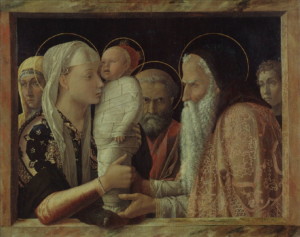[The following is from the program notes from our last celebration of Solemn Vespers.]
The Law of Moses prescribes that childbirth renders the mother ritually impure for a period of forty days after the birth of a male child and eighty days in the case of a female child [Leviticus 12: 1-5]. Thus it comes about that today’s feast, falling forty days after Christmas, was until recently referred to as the Purification of the Blessed Virgin Mary. It is this connection with Christmas that warrants our keeping the Christmas tree lit throughout this time. Tomorrow, we turn more purposely toward the penitential seasons of Septuagesima and Lent, and ultimately toward the Cross, foreshadowed in so many ways in our Lord’s first temple appearance today.
Like most of the Torah, the theology and practical implications of this ruling regarding a mother’s purification are manifold. We should be cautious when interpreting its meaning lest we project twenty-first century biases onto Iron Age civilization. Practically speaking the forty or eighty day period helped to assure that the mother and child would be together in the home. But it is the theology behind the notion of ritual purity that is worth examining this evening.
The book of Leviticus is a book concerned preeminently with holiness. It is easy for us to imagine, reading the multiform (and often enough picayune) mandates of Torah, that holiness is a matter of correct action, detailed obedience to ritual behaviors that separated one out from the “profane.” There is something to this, but if we stop there, we miss the great beauty that is the vision of the temple priesthood. The priests who authored the book of Leviticus also, according to most scholars, authored or edited the majestic creation account that opens the book of Genesis.
In this great of the newborn cosmos, God’s holiness is manifested mainly in the fecundity of His Word and Spirit. God is the God of the living. When God speaks, His Word gives life, an abundant life, overflowing with richness, newness, variety, order, and surprise. In Israelite priestly theology, God comes to reside in the temple, and it is from the temple that this life-giving, bountiful energy bursts forth, especially at the hour of the sacrifices. This theology will find its ultimate expression in the sacrificial opening of the side of Christ, the holiest of victims, from which pours forth the life-giving sacraments of the Church.
Before I get too far ahead of myself, let’s return to the book of Leviticus. The priests aimed to manifest this holiness, holiness-as-life, by restricting access to the temple, allowing only persons who showed no marks that signified death. These defiling marks could be in the form of blemished skin, illness, or recent contact with a corpse. Death has no place in the temple, which is understood as a kind of restoration of Eden, a foretaste of the Kingdom of God toward which the temple points. It is noteworthy that in the book of Revelation, heaven has no temple; there is no need, for death is no more.
What has this to do with childbirth? Three thousand years ago, childbirth was far more likely to cause death in the child or the mother than is the case today. The entrance of a child into the world comes with the shedding of much blood, and this is a sign that birth is, in this fallen world, tainted with accents of death. It is also the case that the first weeks of life are precarious for newborns, more so again in the premodern world. Until the health of both mother and child are established, they remain in this hazardous state. The purification of the mother and presentation of the child are a kind of resurrection, a reintroduction of both into the land of the living.
Thus it is that Jesus’s first visit to the temple so profoundly foreshadows His salvific mission. His very birth is already an acceptance of death, as is Mary’s fiat, ratifying her participation in the Passion of Christ. And just as at the Easter Vigil, candles signify the light of Christ that overwhelms the darkness, at Mass on today’s feast, the faithful bear blessed candles (hence another traditional name, “Candlemas”). The prophet Simeon stands in not only for Israel, but for us. As he sees the significance of the event by the power of the Holy Spirit, may we be enlightened by the same Spirit, that our faith in the life-giving power of God may be deepened. May our understanding of what Christ is accomplishing in us grow through our participation in today’s Joyful Mystery!
